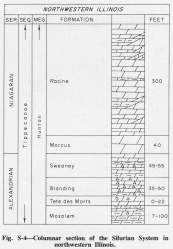Blanding Formation
Lithostratigraphy: Hunton Limestone Megagroup >>Blanding Formation
Chronostratigraphy: Paleozoic Erathem >>Silurian System >>Alexandrian Series
Allostratigraphy: Tippecanoe Sequence
Primary source
Willman, H. B., Elwood Atherton, T. C. Buschbach, Charles Collinson, John C. Frye, M. E. Hopkins, Jerry A. Lineback, and Jack A. Simon, 1975, Handbook of Illinois Stratigraphy: Illinois State Geological Survey Bulletin 95, 261 p.
Contributing author(s)
H. B. Willman and Elwood Atherton
Name
Original description
Derivation
The Blanding Formation is named for the village of Blanding, Jo Daviess County.
Other names
The formation was originally named "Waucoma" (Savage, 1914) but later was assigned to the Kankakee Dolomite (Savage, 1926).
History/background
Type section
Type location
The type section of the Blanding Formation is located 3 miles north of Blanding, Jo Daviess County, in the upper part of the Mississippi River bluffs (SE SW SE 21, 27N-1E), where the formation is 51.5 feet thick.
Type author(s)
Type status
Reference section
Reference location
Reference author(s)
Reference status
Stratigraphic relationships
The Blanding Formation (Willman, 1973, p. 35) (fig. S-4) overlies the Tete des Morts Formation in northwestern Illinois.
Extent and thickness
The Blanding Formation is commonly 35-50 feet thick, and is widely exposed both north and south of the Savanna Anticline, along which it is eroded.
Lithology
The Blanding Formation consists of brownish to pinkish gray, fine-grained, slightly argillaceous to pure dolomite in 2-6 inch beds. It contains layers of white chert, most of them 1-3 inches thick and commonly separated by 4-6 inches of dolomite. In some localities chert forms 50 percent of the upper part of the formation. The cherty residuum above the Tete des Morts Formation on many of the mounds in the Driftless Area is derived from the Blanding Formation. The basal 3-8 feet of the formation at some places contains only a little chert, largely in scattered nodules. The dolomite in this basal zone is slightly more argillaceous than that above, and it may be equivalent to a thicker well bedded zone quarried for building stone, the "quarry beds," farther west in Iowa.
Core(s)
Photograph(s)
Contacts
Well log characteristics
Fossils
Silicified corals are common in the Blanding, and Savage (1926) listed other fossils.
Age and correlation
The Blanding Formation is similar in lithology to the Elwood Formation in northeastern Illinois, but the latter has been traced in subsurface westward only to Peru, La Salle County, and the equivalence of the two units is not considered established.
Environments of deposition
Economic importance
Remarks
References
SAVAGE, T. E., 1914, Relations of the Alexandrian Series in Illinois and Missouri to the Silurian section of Iowa: American Journal of Science, v. 38, p. 28-37.
SAVAGE, T. E., 1926, Silurian rocks of Illinois: Geological Society of America Bulletin, v. 37, p. 513-533.
WILLMAN, H. B., 1973, Rock stratigraphy of the Silurian System in northeastern and northwestern Illinois: Illinois State Geological Survey Circular 479, 55 p.
ISGS Codes
| Stratigraphic Code | Geo Unit Designation |
|---|---|
